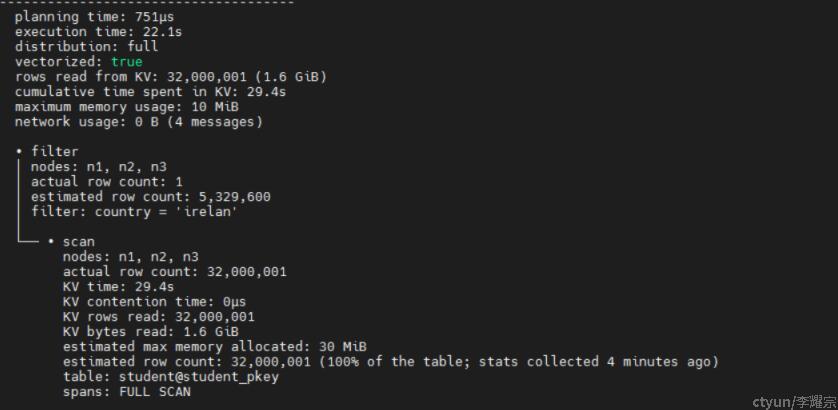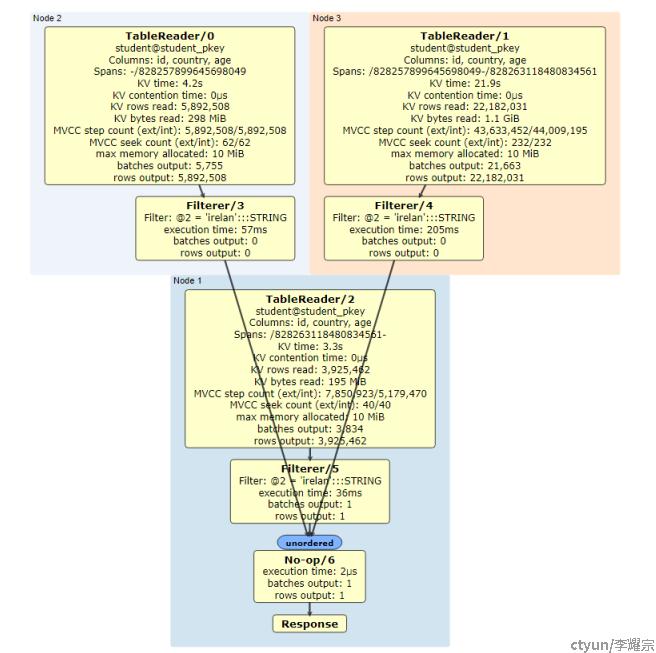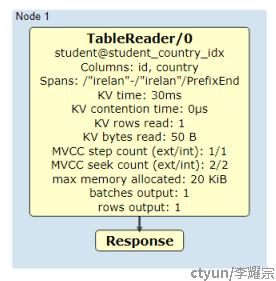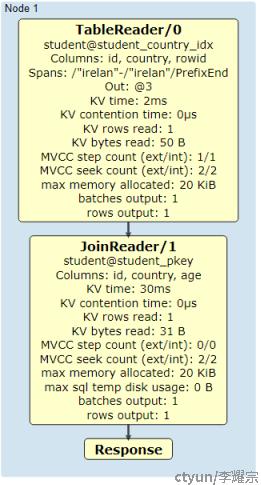省流版:
1、CRDB的执行计划大致与PG相当, 语法增加了distsql关键字,用于查询分布式的执行计划
2、提供了网页链接进行图形化展示,更加清晰明了
CR的执行计划
上述的读场景和写场景是针对一个表只有一个range的场合进行的简单描述,正如我们在章节一中的student表,3200w行数据,分成了7个range。
那么如果我们查询其中的某些数据,需要访问哪些range?
这里可以依赖CR的查看执行计划功能来了解查询的具体过程。所有关系型数据库都具备执行计划这个概念,简单地说,就是展示数据库引擎是通过何种途径去查询数据。
比如现在已知student表中的数据分布如下:

现在我通过如下命令查看“查询irelan的数据的执行计划”
explain analyze (distsql) select * from student where country = 'irelan';

由上图可知
planning time:生成执行计划的耗时为751us
execution time:执行上述查询的耗时为22.1s
row read from KV:从KV中读取的行数32000001(1.6GB)
cumulative time spent in KV: 累计在KV的读取耗时29.4s (多节点耗时累加,因为是并行所以实际耗时小于该值)
maximum memory usage: 最大内存消耗 10MB
filter:过滤器
nodes:涉及的节点(如上图,所有节点都访问到了)
actual row count : 1
estimated row count : 5329600 预估的行数
filter: 过滤条件
sacn:子操作,扫描,执行了FULL SCAN,全表扫描,总计扫描32000001行,KV耗时29.4秒,KV读取数据量1.6GB,通过student@student_pkey进行全表扫描。
CR还提供了一个网页,观察图形化的执行计划

如图所示,Node1、Node2和Node3分别执行全表扫描,并将得到的数据流经过Filterer @2 = 'irelan':::STRING 过滤,得到的结果发送到Node1进行No-op6 汇总,得到输出行数为1,并最终反馈Response给客户端。
整个过程中,耗时最多的是Node3进行KV读取,耗时21.9秒;Node3的Filter耗时205ms,其他环节耗时基本上是10+毫秒级别,汇总耗时为2us,总耗时为22.1秒。
PS:关于任意一个节点是如何知道数据range的分布情况,可以参考官网架构文档中的Distributed Layer章节中关于Meta range的说明。
CR的索引
上面的查询虽然带了查询条件 where country = 'irelan';, 但是由于没有合适的索引,因此进行了全表扫描。像普通关系型数据库一样,可以通过索引来提高查询效率。同时,由于CR的索引也是通过KV存储的,因此如果使用恰当的索引方式,甚至可以进一步提高查询效率。
比方说,执行如下SQL进行索引创建:
CREATE INDEX ON student (country) STORING (id);
该命令的意思是针对student表,基于country字段进行索引,并且在索引中存储id字段的数据。
下面我们看看以下两个查询的执行计划
explain analyze (distsql) select id,country from student where country = 'irelan';
-----------------------------------------------------------------------------------------------------
planning time: 809µs
execution time: 31ms
distribution: local
vectorized: true
rows read from KV: 1 (50 B)
cumulative time spent in KV: 30ms
maximum memory usage: 20 KiB
network usage: 0 B (0 messages)
• scan
nodes: n1
actual row count: 1
KV time: 30ms
KV contention time: 0µs
KV rows read: 1
KV bytes read: 50 B
estimated max memory allocated: 20 KiB
estimated row count: 0 (<0.01% of the table; stats collected 9 minutes ago)
table: student@student_country_idx
spans: [/'irelan' - /'irelan']
Time: 34ms total (execution 33ms / network 1ms)

只经过节点1,即可返回数据,通过student@student_country_idx进行查询,访问了新建的索引student_country_idx的range即可得到结果。
explain analyze (distsql) select id,country,age from student where country = 'irelan';
-------------------------------------------------------
planning time: 654µs
execution time: 33ms
distribution: local
vectorized: true
rows read from KV: 2 (81 B)
cumulative time spent in KV: 32ms
maximum memory usage: 50 KiB
network usage: 0 B (0 messages)
• index join
│ nodes: n1
│ actual row count: 1
│ KV time: 30ms
│ KV contention time: 0µs
│ KV rows read: 1
│ KV bytes read: 31 B
│ estimated max memory allocated: 20 KiB
│ estimated max sql temp disk usage: 0 B
│ estimated row count: 0
│ table: student@student_pkey
│
└── • scan
nodes: n1
actual row count: 1
KV time: 2ms
KV contention time: 0µs
KV rows read: 1
KV bytes read: 50 B
estimated max memory allocated: 20 KiB
estimated row count: 0 (<0.01% of the table; stats collected 48 seconds ago)
table: student@student_country_idx
spans: [/'irelan' - /'irelan']
Time: 35ms total (execution 35ms / network 1ms)

类似的查询,得到了不一样的执行计划,原因在于:经过索引查询得到id,country列的数据,但是无法得到age列,因此需要在索引中查到的rowid进一步利用主键student_pkey查询相应的表数据range,得到age字段的数据,总共访问了2个range合计2条KV。
因此,当节点数和range数线性扩展时,存在两种情况:
1、查询的字段在索引中完全包含,那么查询可以快速通过索引就得到结果,无须访问过多的range。由于索引组织的数据是有序的,因此也不用担心同一个user_id所涉及的数据会分散在所有range中。
2、查询的字段在索引中未能完全包含,仅能通过索引快速找到需要访问的数据range,并进一步查询。由于range被平均分布在所有节点中,理论上整个查询的耗时约等于最多range的节点的查询的耗时。数据分散在多个节点不一定比传统数据库(通过分片键分布数据)的效率低。(比方说,100w数据都由节点1去查询的耗时 VS 每个节点查询33w数据再汇总的耗时)